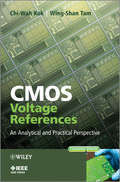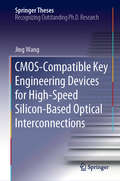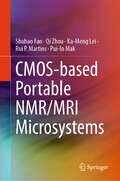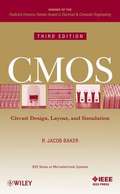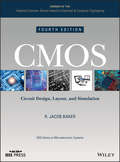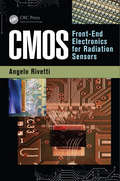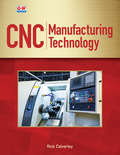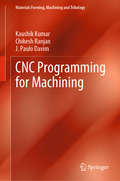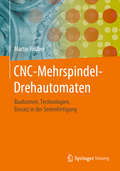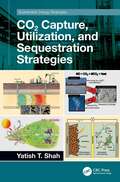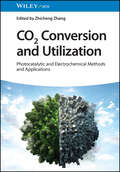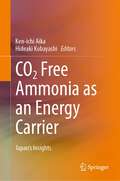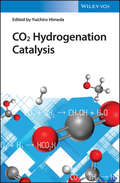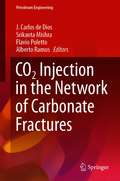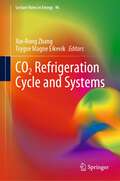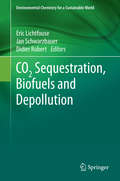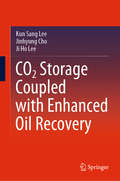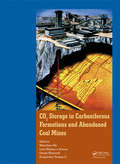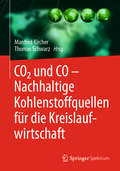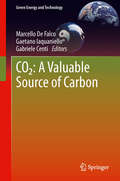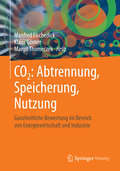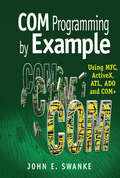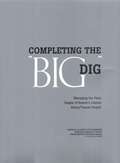- Table View
- List View
CMOS Voltage References: An Analytical and Practical Perspective (Wiley - IEEE)
by Wing-Shan Tam Chi-Wah KokA practical overview of CMOS circuit design, this book covers the technology, analysis, and design techniques of voltage reference circuits. The design requirements covered follow modern CMOS processes, with an emphasis on low power, low voltage, and low temperature coefficient voltage reference design. Dedicating a chapter to each stage of the design process, the authors have organized the content to give readers the tools they need to implement the technologies themselves. Readers will gain an understanding of device characteristics, the practical considerations behind circuit topology, and potential problems with each type of circuit. Many design examples are used throughout, most of which have been tested with silicon implementation or employed in real-world products. This ensures that the material presented relevant to both students studying the topic as well as readers requiring a practical viewpoint. Covers CMOS voltage reference circuit design, from the basics through to advanced topics Provides an overview of basic device physics and different building blocks of voltage reference designs Features real-world examples based on actual silicon implementation Includes analytical exercises, simulation exercises, and silicon layout exercises, giving readers guidance and design layout experience for voltage reference circuits Solution manual available to instructors from the book’s companion website This book is highly useful for graduate students in VLSI design, as well as practicing analog engineers and IC design professionals. Advanced undergraduates preparing for further study in VLSI will also find this book a helpful companion text.
CMOS and Beyond
by Tsu-Jae King Liu Kelin KuhnGet up to speed with the future of logic switch design with this indispensable overview of the most promising successors to modern CMOS transistors. Learn how to overcome existing design challenges using novel device concepts, presented using an in-depth, accessible, tutorial-style approach. Drawing on the expertise of leading researchers from both industry and academia, and including insightful contributions from the developers of many of these alternative logic devices, new concepts are introduced and discussed from a range of different viewpoints, covering all the necessary theoretical background and developmental context. Covering cutting-edge developments with the potential to overcome existing limitations on transistor performance, such as tunneling field-effect transistors (TFETs), alternative charge-based devices, spin-based devices, and more exotic approaches, this is essential reading for academic researchers, professional engineers, and graduate students working with semiconductor devices and technology.
CMOS-Compatible Key Engineering Devices for High-Speed Silicon-Based Optical Interconnections (Springer Theses)
by Jing WangThis book discusses some research results for CMOS-compatible silicon-based optical devices and interconnections. With accurate simulation and experimental demonstration, it provides insights on silicon-based modulation, advanced multiplexing, polarization and efficient coupling controlling technologies, which are widely used in silicon photonics. Researchers, scientists, engineers and especially students in the field of silicon photonics can benefit from the book. This book provides valuable knowledge, useful methods and practical design that can be considered in emerging silicon-based optical interconnections and communications. And it also give some guidance to student how to organize and complete an good dissertation.
CMOS-based Portable NMR/MRI Microsystems
by Qi Zhou Pui-In Mak Ka-Meng Lei Rui P. Martins Shuhao FanThis book describes the complete design of CMOS-based multi-nuclear NMR/MRI microsystems. The authors emphasize optimizing semiconductor chip design to enhance the performance of compact CMOS-based NMR/MRI systems. They also discuss the integrated circuit design of customized modules, such as 3-D gradient controllers specifically for MRI, high-resolution multi-phase generators for advanced composite radio-frequency excitation pulse synthesis, etc. The integration of these specific modules not only drives system innovation but also expands functionality. Discusses developments in CMOS integrated circuit design for miniaturized NMR/MRI platforms over recent decades; Focuses on key integrated circuit design considerations for transceivers in compact NMR systems; Details the design of application-specific integrated circuits (ASICs) for a miniaturized 3-D MRI platform and a compact multi-nuclei NMR/MRI system, both featuring a portable magnet, for enhanced accessibility.
CMOS: Circuit Design, Layout, and Simulation
by R. Jacob BakerThe Third Edition of CMOS Circuit Design, Layout, and Simulation continues to cover the practical design of both analog and digital integrated circuits, offering a vital, contemporary view of a wide range of analog/digital circuit blocks including: phase-locked-loops, delta-sigma sensing circuits, voltage/current references, op-amps, the design of data converters, and much more. Regardless of one's integrated circuit (IC) design skill level, this book allows readers to experience both the theory behind, and the hands-on implementation of, complementary metal oxide semiconductor (CMOS) IC design via detailed derivations, discussions, and hundreds of design, layout, and simulation examples.
CMOS: Circuit Design, Layout, and Simulation (IEEE Press Series on Microelectronic Systems #7)
by R. BakerThe fourth edition of CMOS: Circuit Design, Layout, and Simulation is an updated guide to the practical design of both analog and digital integrated circuits. The author—a noted expert on the topic—offers a contemporary review of a wide range of analog/digital circuit blocks including: phase-locked-loops, delta-sigma sensing circuits, voltage/current references, op-amps, the design of data converters, and switching power supplies. <p><p> CMOS includes discussions that detail the trade-offs and considerations when designing at the transistor-level. The companion website contains numerous examples for many computer-aided design (CAD) tools. Using the website enables readers to recreate, modify, or simulate the design examples presented throughout the book. In addition, the author includes hundreds of end-of-chapter problems to enhance understanding of the content presented. <p> Written for students in electrical and computer engineering and professionals in the field, the fourth edition of CMOS: Circuit Design, Layout, and Simulation is a practical guide to understanding analog and digital transistor-level design theory and techniques.
CMOS: Front-End Electronics for Radiation Sensors (Devices, Circuits, and Systems #42)
by Angelo RivettiCMOS: Front-End Electronics for Radiation Sensors offers a comprehensive introduction to integrated front-end electronics for radiation detectors, focusing on devices that capture individual particles or photons and are used in nuclear and high energy physics, space instrumentation, medical physics, homeland security, and related fields. Emphasizing practical design and implementation, this book: Covers the fundamental principles of signal processing for radiation detectors Discusses the relevant analog building blocks used in the front-end electronics Employs systematically weak and moderate inversion regimes in circuit analysis Makes complex topics such as noise and circuit-weighting functions more accessible Includes numerical examples where appropriate CMOS: Front-End Electronics for Radiation Sensors provides specialized knowledge previously obtained only through the study of multiple technical and scientific papers. It is an ideal text for students of physics and electronics engineering, as well as a useful reference for experienced practitioners.
CNC Machining
by Richard A. GizelbachCNC Machining contains the information and concepts needed to help the student progress from simple manual machining to an efficient use of CNC milling machines, lathes, and electrical discharge machines. The content is presented with clear text and easy-to-follow drawings and photos. • Each chapter includes Objectives, Technical Terms, and Review Questions. • Full-color photos and illustrations help the reader understand the various components of CNC machines and tools. • The material in this book applies to a wide variety of CNC machines, not just one specific manufacturer. • The math required for efficient and accurate machining is covered in this book in a way that ensures all students are prepared.
CNC Manufacturing Technology
by Rick CalverleyCNC Manufacturing Technology helps to prepare learners for entry-level CNC technician positions in today’s advanced manufacturing industry. Early foundational chapters create an awareness of career opportunities, stress the importance of shop safety, and show how math is used in machining. Subsequent chapters develop a broad base of knowledge of basic machining skills such as print reading and the use of measuring instruments. The author employs a building-block approach to present in-depth coverage of CNC equipment, cutting tools and inserts, CNC mill and CNC lathe programming, CAM, multiaxis programming, and additional advanced topics. Extensive use of artwork, photographs, and code examples help students to visualize CNC programming and equipment operation.
CNC Programming for Machining (Materials Forming, Machining and Tribology)
by J. Paulo Davim Kaushik Kumar Chikesh RanjanThe book is basically written with a view to project Computer Numerical Control Programming (CNC) Programming for machines. This book shows how to write, read and understand such programs for modernizating manufacturing machines. It includes topics such as different programming codes as well as different CNC machines such as drilling and milling.
CNC-Mehrspindel-Drehautomaten: Bauformen, Technologien, Einsatz in der Serienfertigung
by Martin ReuberDieses Fachbuch belegt, dass der moderne CNC-Mehrspindel-Drehautomat eine außerordentlich hohe Produktivität mit den wesentlichen Merkmalen einer flexiblen Fertigung vereint. Es vermittelt grundlegende Kenntnisse über die Maschinen- und Prozesstechnologie, stellt auf Mehrspindlern eingesetzte Technologien und Anwendungen vor und erläutert die spezifischen Besonderheiten und Anforderungen der mehrspindligen Produktion. Es wird dargestellt, welche Potenziale und Wettbewerbsvorteile sich mit innovativen Maschinenkonzepten und Fertigungstechnologien erschließen und erzielen lassen.
CO2 Capture, Utilization, and Sequestration Strategies (Sustainable Energy Strategies)
by Yatish T. ShahOffering practical treatment strategies for CO2 emission generated from various energy-related sources, CO2 Capture, Utilization, and Sequestration Strategies emphasizes carbon capture, utilization, and sequestration (CCUS) with special focus on methods for each component of the strategy. While other books mostly focus on CCS strategy for CO2, this book details the technologies available for utilization of CO2, showing how it can be a valuable renewable source for chemicals, materials, fuels, and power instead of a waste material damaging the environment. Highlights current and potential future commercially viable CCUS strategies Discusses applications for direct and the more complex indirect utilization of CO2 streams Examines viability of the mineral carbonation process and biological treatments to convert CO2 into useful biochemicals, biomaterials, and biofuels Explores heterogeneous catalysis for thermal and electrochemical conversion and solar energy-based thermal, photo-thermal, and photocatalytic conversion of CO2 Presents the rapidly growing concept of plasma-activated catalysis for CO2 conversion CO2 Capture, Utilization, and Sequestration Strategies is a valuable reference for researchers in academia, industry, and government organizations seeking a guide to effective CCUS processes, technologies, and applications.
CO2 Conversion and Utilization: Photocatalytic and Electrochemical Methods and Applications
by Zhicheng ZhangCO2 Conversion and Utilization Comprehensive overview of current development of various catalysts in CO2 conversion and utilization through photocatalytic and electrochemical methods CO2 Conversion and Utilization systematically summarizes the development of CO2 photo- and electro-conversion and utilization, especially the reaction mechanism, engineering and technology of testing, and preparation methods and physicochemical properties of various catalytic materials. The rational design and preparation of catalysts, development of characterization technologies, and in-depth understanding of catalytic mechanisms are systematically discussed. In particular, the various parameters influencing the photocatalytic and electrochemical CO2 reduction are emphasized. The underlying challenges and perspectives for the future development of efficient catalysts for CO2 reduction to specific chemicals and fuels are discussed at the end of the text. Written by a highly qualified author with significant experience in the field, CO2 Conversion and Utilization includes information on: Measurement systems and parameters for CO2 photo/electro-conversion, CO2 photo/electro-conversion mechanism, and Cu-based and Cu-free metal materials for electrocatalytic CO2 reduction Organic-inorganic, metal organic framework, and covalent organic framework hybrid materials for CO2 photo/electro-conversion Single/dual-atom catalysts, homogeneous catalysts, and high-entropy alloys for CO2 photo/electro-conversion Semiconductor composite and carbon-based materials for photocatalytic CO2 reduction, novel routes for CO2 utilization via metal-CO2 batteries, and CO2 conversion into long-chain compounds Providing comprehensive coverage of the subject, CO2 Conversion and Utilization is of high interest for scientific researchers as well as engineers and technicians in industry, including but not limited to photochemists, electrochemists, environmental chemists, catalytic chemists, chemists in industry, and inorganic chemists.
CO2 Free Ammonia as an Energy Carrier: Japan's Insights
by Ken-Ichi Aika Hideaki KobayashiThis book describes important findings in intensive studies conducted in Japan on ammonia as an energy carrier. It illustrates an advanced solar-heat capture system and storage materials at 600°C and hydrogen production with SOECs and a new IS method through the use of heat. New industrial ammonia catalysts and a demonstration process that started running in Fukushima are also introduced. Advanced ammonia decomposition catalysts and the process that were developed for use by the hydrogen station are presented. An advanced direct ammonia fuel cell was developed and the base data are shown. The book explains that ammonia is used as a fuel for industrial applications because its burning can be controlled without emitting extra NOx in the gas turbine and the real coal co-fired power plant. These breakthroughs have made a strong impact in the world as a practical technology for CO2 reduction. Also provided here are the scientific and industrial backgrounds as well as the environmental assessment and economic evaluation for the future.This book will be helpful for all who are interested in energy technology—researchers, students, and strategy planners at companies and in the government.
CO2 Hydrogenation Catalysis
by Yuichiro HimedaA guide to the effective catalysts and latest advances in CO2 conversion in chemicals and fuels Carbon dioxide hydrogenation is one of the most promising and economic techniques to utilize CO2 emissions to produce value-added chemicals. With contributions from an international team of experts on the topic, CO2 Hydrogenation Catalysis offers a comprehensive review of the most recent developments in the catalytic hydrogenation of carbon dioxide to formic acid/formate, methanol, methane, and C2+ products. The book explores the electroreduction of carbon dioxide and contains an overview on hydrogen production from formic acid and methanol. With a practical review of the advances and challenges in future CO2 hydrogenation research, the book provides an important guide for researchers in academia and industry working in the field of catalysis, organometallic chemistry, green and sustainable chemistry, as well as energy conversion and storage. This important book: Offers a unique review of effective catalysts and the latest advances in CO2 conversion Explores how to utilize CO2 emissions to produce value-added chemicals and fuels such as methanol, olefins, gasoline, aromatics Includes the latest research in homogeneous and heterogeneous catalysis as well as electrocatalysis Highlights advances and challenges for future investigation Written for chemists, catalytic chemists, electrochemists, chemists in industry, and chemical engineers, CO2 Hydrogenation Catalysis offers a comprehensive resource to understanding how CO2 emissions can create value-added chemicals.
CO2 Injection in the Network of Carbonate Fractures (Petroleum Engineering)
by Alberto Ramos J. Carlos de Dios Srikanta Mishra Flavio PolettoThis book presents guidelines for the design, operation and monitoring of CO2 injection in fractured carbonates, with low permeability in the rock matrix, for geological storage in permanent trapping. CO2 migration is dominated by fractures in formations where the hydrodynamic and geochemical effects induced by the injection play a key role influencing the reservoir behavior. CO2 injection in these rocks shows specific characteristics that are different to injection in porous media, as the results from several research studies worldwide reveal. All aspects of a project of this type are discussed in this text, from the drilling to the injection, as well as support works like well logging, laboratory and field tests, modeling, and risk assessment. Examples are provided, lesson learned is detailed, and conclusions are drawn. This work is derived from the experience of international research teams and particularly from that gained during the design, construction and operation of Hontomín Technology Development Plant. Hontomín research pilot is currently the only active onshore injection site in the European Union, operated by Fundación Ciudad de la Energía-CIUDEN F.S.P. and recognized by the European Parliament as a key test facility. The authors provide guidelines and tools to enable readers to find solutions to their problems. The book covers activities relevant to a wide range of practitioners involved in reservoir exploration, modeling, site operation and monitoring. Fluid injection in fractured media shows specific features that are different than injection in porous media, influencing the reservoir behavior and defining conditions for safe and efficient operation. Therefore, this book is also useful to professionals working on oil & gas, hydrogeology and geothermal projects, and in general for those whose work is related to activities using fluid injection in the ground.
CO2 Refrigeration Cycle and Systems (Lecture Notes in Energy #96)
by Xin-Rong Zhang Trygve Magne EikevikThis book covers the fundamentals and applications of carbon dioxide vapor compression refrigeration thermodynamic cycles. In particular, it presents new application areas, such as making ice and snow in the Winter Olympic Games, food cooling and refrigeration. The book explores the physical and chemical characteristics of CO2 fluid, and the unique traits of its thermodynamic cycle. The contributors explain how CO2 refrigeration is a developing, eco-friendly technology, and emphasize its importance for refrigeration and air-conditioning in the current and future market.This book is a valuable source of information for researchers, engineers and policy makers looking to expand their applicable knowledge of high-potential refrigeration technology using carbon dioxide. It is also of interest to postgraduate students and practitioners looking for an academic insight into the industry’s latest eco-friendly technologies.
CO2 Sequestration, Biofuels and Depollution (Environmental Chemistry for a Sustainable World #5)
by Eric Lichtfouse Jan Schwarzbauer Didier RobertWater is the driving force of all nature. This old quote from Leonardo da Vinci reminds us that without water life is simply not possible. As a consequence, water is probably the most important wealth for humanity. In spite of this, drinking water is still polluted by man-made toxicals gathered by waters in soils and the atmosphere. This book presents advanced methods to clean water and air. Chapters also focus on biofuels, greenhouse gases and genetically modified crops.
CO2 Storage Coupled with Enhanced Oil Recovery
by Kun Sang Lee Jinhyung Cho Ji Ho LeeThis book provides a comprehensive and detailed description of the various mechanisms of the CCS–EOR process. Whereas previous texts have primarily focused on carbon capture and storage (CCS) and enhanced oil recovery (EOR) separately, this book provides a general overview of both technologies when used together. Coupled CCS–EOR technology has become increasingly important, as it overcomes the respective shortcomings of the two technologies. The book presents an integrated numerical model including the hysteresis effect, solubility trapping, miscibility, and formation damage by asphaltene deposition. The experimental and model-based evaluation of fluid properties is also discussed. The book concludes by discussing the latest research into CO2 storage coupled with EOR, most notably performance control by including additives in CO2 injection, and CO2 injection into shale reservoirs. Ideally suited for graduate students and researchers in the fields of carbon capture, utilisation, and storage, the book shares essential insights into maximising the efficiency of CCS and EOR alike.
CO2 Storage in Carboniferous Formations and Abandoned Coal Mines
by Manchao He Luis Ribeiro e Sousa Derek Elsworth Euripedes VargasUnderground geological storage of carbon dioxide (CO2) has considerable potential for mitigating climate change. CO2 can be safely injected and stored at well characterized and properly managed sites. Injecting carbon dioxide in deep geological formations can store it underground for long periods of time. Depleted oil and gas reservoirs, saline aqu
CO2 und CO – Nachhaltige Kohlenstoffquellen für die Kreislaufwirtschaft
by Thomas Schwarz Manfred KircherKlimaschutz und Rohstoffwandel erfordern für die Chemie- und Treibstoffindustrie neue, nachhaltige Kohlenstoffquellen. Tatsächlich erreichen Verfahren, die kohlenstoffhaltige Emissions- und Gasströme industriell verwerten, die industrielle Praxis. Sie werden auch in Europa einen wichtigen Beitrag zur Senkung der Kohlenstoff-Emission und für den Einstieg in eine echte Kohlenstoff-Kreislaufwirtschaft leisten.Dieses Buch beschreibt die Grundlagen chemischer und biotechnologischer Verfahren zur Umsetzung von CO und CO2 zu Chemikalien und Treibstoffen und geht auf das Potential für die produzierende Wirtschaft, Industriestandorte und Regionen ein:Welche Emissions- und Gasströme bieten Rohstoffpotential? Welche Verfahren werden bereits implementiert, werden geprüft und sind in Entwicklung?Welche Produkte können aus gasförmigen Kohlenstoffquellen hergestellt werden?Wie können Kohlenstoff abgebende und verbrauchende Industrien zu neuen Wertschöpfungsketten verknüpft werden?Wie sehen die regulatorischen Rahmenbedingungen aus?Wie sieht der ökologische Fußabdruck aus?Wie tragen die neuen Verfahren zur regionalen Wirtschaft bei und unterstützen damit die gesellschaftliche Akzeptanz?
CO2: A Valuable Source Of Carbon (Green Energy and Technology)
by Gaetano Iaquaniello Marcello De Falco Gabriele CentiAs the annual production of carbon Dioxide (CO2) reaches 30 billion tones, the growing issue of the greenhouse effect has triggered the development of technologies for CO2 sequestration, storage and use as a reactant. Collecting together the reports of the Congress at University of Rome (Campus Bio-medico) held 16th April 2012, CO2: A Valuable Source of Carbon presents and discusses promising technologies for the industrial exploitation of CO2. Divided into two parts, the current technology is evaluated and summarized before European and national projects are presented. The focus on CO2 recovery, particularly in value-added production, proposes applicable methods to develop sustainable practices and even to mitigate greenhouse gas emission from large-scale fossil fuels usage. Including current data and real-world examples, CO2: A valuable source of carbon provides students, engineers, researchers and industry professional with up-to-date material and potential areas for development and research.
CO2: Ganzheitliche Bewertung im Bereich von Energiewirtschaft und Industrie
by Manfred Fischedick Klaus Görner Margit ThomeczekAusgehend von den naturwissenschaftlichen und technischen Grundlagen werden in dem Band Technologien zur Abscheidung, Speicherung und Nutzung von klimasch#65533;dlichem CO2 vorgestellt. Der Stand der Technik wird dargelegt, die Energiebilanzen verschiedener Techniken verglichen, rechtliche, wirtschaftliche und gesellschaftspolitische Aspekte beschrieben und dar#65533;ber hinaus die Standpunkte der verschiedenen Interessengruppen vorgestellt. Um sachlich informieren zu k#65533;nnen, legen die Autoren die Kriterien f#65533;r die Bewertung der einzelnen Sichtweisen offen.
COM Programming by Example: Using MFC, ActiveX, ATL, ADO, and COM+
by John SwankeUse MFC, ActiveX, ATL, ADO and COM+ to develop COM applications Implement client/server applications with ease with this example-oriented approach to the details and implementation of COM technology in network applications. If there was ever a subject th
COMPLETING THE "BIG DIG": Managing the Final Stages of Boston's Central Artery/Tunnel Project
by National Research Council National Academy of Engineering Transportation Research Board of the National AcademiesBoston's Central Artery/Tunnel Project, a 7.8 mile system of bridges and underground highways and ramps, is the most expensive public works project ever undertaken in the United States. The original cost estimate of $2.6 billion has already been exceeded by $12 billion, and the project will not be completed until 2005, seven years late. The Massachusetts Turnpike Authority (MTA), the public steward of the project, requested that the National Research Council carry out an independent assessment of the project's management and contract administration practices, with a focus on the present situation and measures that should be taken to bring the project to a successful conclusion. This report presents the committee's findings and recommendations pertaining to cost, scheduling, and transitioning from the current organization dominated by consultants to an operations organization composed largely of full-time MTA staff. The report recommends that MTA establish an external, independent, peer-review program to address technical and management issues until the transition to operations and maintenance is complete; begin a media campaign now to teach drivers how to use the new system safely; and develop, immediately implement, and maintain a comprehensive security program.
